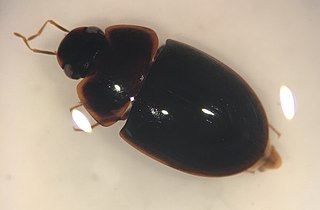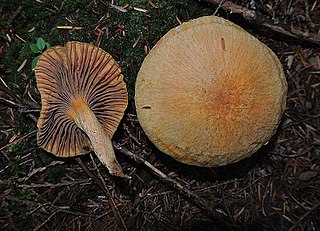
The southern frogs form the Leptodactylidae, a name that comes from Greek meaning a bird or other animal having slender toes. They are a diverse family of frogs that most likely diverged from other hyloids during the Cretaceous. The family has undergone major taxonomic revisions in recent years, including the reclassification of the former subfamily Eleutherodactylinae into its own family the Eleutherodactylidae; the Leptodactylidae now number 206 species in 13 genera distributed throughout Mexico, the Caribbean, and Central and South America. The family includes terrestrial, burrowing, aquatic, and arboreal members, inhabiting a wide range of habitats.

Martins's tamarin or Martin's ochraceous bare-face tamarin, is a species of tamarin endemic to Brazil.

The ochraceous wren is a small songbird of the wren family. It is a resident breeding species in Costa Rica, Panama, and Colombia.

Chroogomphus is a genus of mushrooms commonly known as pine-spikes or spike-caps based on their shape and because they are often found growing in association with pine trees. The genus is distributed throughout the Northern Hemisphere including North America, the Caribbean, Europe, and Asia.

Pisaster ochraceus, generally known as the purple sea star, ochre sea star, or ochre starfish, is a common seastar found among the waters of the Pacific Ocean. Identified as a keystone species, P. ochraceus is considered an important indicator for the health of the intertidal zone.

Sea star wasting disease or starfish wasting syndrome is a disease of starfish and several other echinoderms that appears sporadically, causing mass mortality of those affected. There are approximately 40 species of sea stars that have been affected by this disease. At least 20 of these species were on the Northwestern coast of Mexico to Alaska. The disease seems to be associated with increased water temperatures in some locales, but not others. It starts with the emergence of lesions, followed by body fragmentation and death. In 2014 it was suggested that the disease is associated with a single-stranded DNA virus now known as the sea star-associated densovirus (SSaDV). However, this hypothesis was refuted by recent research in 2018 and 2020. Sea star wasting disease is still not fully understood.

Enochrus, a genus of water scavenger beetles, is the third-largest genus of hydrophilids with 222 species in six subgenera worldwide.
Enochrus consors is a species of water scavenger beetle in the family Hydrophilidae. It is found in North America.
Enochrus blatchleyi is a species of water scavenger beetle in the family Hydrophilidae. It is found in North America.
Enochrus cinctus is a species of water scavenger beetle in the family Hydrophilidae. It is found in North America.
Enochrus sayi is a species of water scavenger beetle in the family Hydrophilidae. It is found in North America and Oceania.
Enochrus californicus is a species of water scavenger beetle in the family Hydrophilidae. It is found in Central America and North America.

Enochrus consortus is a species of water scavenger beetle in the family Hydrophilidae. It is found in North America.
Enochrus diffusus is a species of water scavenger beetle in the family Hydrophilidae. It is found in North America.
Enochrus pygmaeus is a species of water scavenger beetle in the family Hydrophilidae. It is found in the Caribbean Sea, Central America, and North America.
Enochrus hamiltoni is a species of water scavenger beetle in the family Hydrophilidae. It is found in North America.
Pseudocentrinus is a genus of flower weevils in the beetle family Curculionidae. There are about nine described species in Pseudocentrinus.

Monalocoris is a genus of plant bugs in the family Miridae. There are about 19 described species in Monalocoris.
Colletes ochraceus is a species of hymenopteran in the family Colletidae. It is found in North America.

Chroogomphus ochraceus is a species of fungus from the family Gomphidiaceae. Known for its close association with conifer trees–especially pines, it is often referred to as the “pine spike” or “spike cap” fungus. C. ochraceus was originally identified as a species limited to the Pacific Northwest because of its display of distinct yellowish colors, but recent research has concluded that this species is widespread across North America and that it is genetically distinct from Chroogomphus rutilus, which is limited to Europe.










